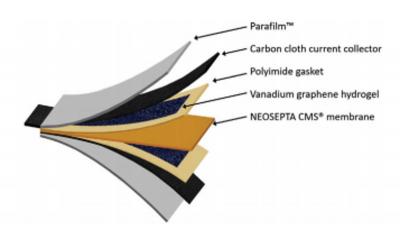Researchers at the Graphene Integrated Functional Technologies (GIFT) Research Cluster at Queen’s University in Canada have developed a novel graphene-based flexible hybrid batterysupercapacitor device.

The device consists of high specific surface area electrodes paired with an electrolyte, which contains a redox species that can exist in more than two oxidation states. The two initially equal half-cells of the device consist of a reduced graphene oxide hydrogel which encapsulates vanadium ions, synthesized with a single-step method.
Operated as a supercapacitor, it retains 95% of the initial capacitance over 1000 cycles. As battery, the losses are more significant, retaining around 50% of the initial capacity. However, these losses during battery operation can be almost entirely restored by electric measures.
The team mentioned that the vanadium ion addition also improves the self-discharge characteristics of the device. Moreover, the self-discharge does not permanently damage the hybrid device since both half-cells initially consist of the same vanadium graphene hydrogel and discharging resets it to initial conditions.
The researchers have designed a facile method to synthesize a hybrid vanadium-graphene hydrogel having the redox activity of the vanadium ions and the high-surface-area of the 3D graphene framework. This device can be operated as a battery, supercapacitor, or hybrid, depending on the operating current density. Its unique power-handling capabilities make it suitable for a wide range of applications.
In future work, the team plans to further increase the energy density of the device by optimization of the one-step synthesis of the vanadium graphene-hydrogel.